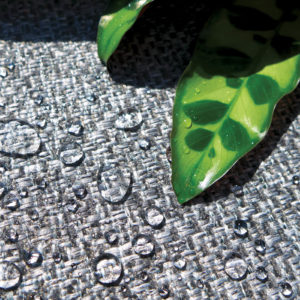
Textile manufacturers are deploying sustainability strategies and forming partnerships to green up products and processes, helping manufacturers meet the requirements of even the most eco-concerned customers—and getting a good start on the circular economy of the future.
For most manufacturers, eco-friendly, sustainable products are becoming a competitive necessity. And as concern over environmental issues has become entrenched among even the most mainstream of consumers, attention is spreading beyond the products themselves into how they’re being produced. In fact, involving the entire supply chain is a key sustainability trend, according to Karla Magruder, founder of Fabrikology International. Based in Hoboken, N.J., the company provides consulting services to the textile supply chain, focusing on sustainable education, development and material sourcing.
“Knowledge is growing,” says Magruder. “For far too long people would talk about sustainability but not have the required understanding to make real progress. Now, this knowledge is making us aware of the effects the textile industry has on the environment; we’re uncovering new issues that need to be addressed.”
One key issue involves reducing the waste stream, keeping materials out of landfills and inspiring the creation of fibers from used textiles and textile waste. “These developments require new partnerships that create closed-loop systems allowing the movement of materials from one business to the next,” Magruder says. “We’re also seeing great progress in innovative fiber developments and textile processing, including new biobased finishes or application methods that are improvements from previous systems.”
What landfills?
Consider Camira Fabrics Ltd. Headquartered in Mirfield, West Yorkshire, United Kingdom, Camira designs and manufactures upholstery using natural and synthetic fibers for commercial interiors, transportation, hospitality, higher education and health care, says Paul Arnold, sustainability manager.
Examples include the company’s felted wool Synergy and Blazer fabrics, incorporating fully traceable New Zealand wool. Camira also uses natural bast fibers from plants like hemp, nettle and flax, blending them with wool. Also on offer is Rivet, a fabric made from 100 percent REPREVE®, a post-consumer recycled polyester derived from polyethylene terephthalate (PET) bottles produced by Unifi Inc., headquartered in Greensboro, N.C. Camira has been manufacturing recycled fabrics and using recycled polyester from post-consumer and post-industrial resources for more 20 years, according to Arnold. Many of its fabrics carry the EU Ecolabel and Oeko-Tex 100 standards.
“We’ve also extended our fabric ranges using environmentally sensitive flax fiber,” Arnold says. “And we’re exploring the production of closed-loop woolen fabrics made from our own waste and take-back scheme material.”
As part of its operating strategies, the company:
- has a five-point sustainability plan encompassing all aspects of operation: people and culture, product and provenance, processes, waste and logistics, community and accreditation.
- operates to ISO 9001 (quality), 14001 (environment), and OHSAS 18001 (health and safety).
- has been a member of the U.K. Furniture Sustainability Program since 2007.
- uses 100 percent recycled or 100 percent rapidly renewable fiber content where possible.
- grows its own hemp and flax fiber in partnership with a Leicestershire (U.K.) farm.
Camira relies on several partnerships to achieve its sustainability objectives. “We work with waste management businesses and our suppliers to improve streaming and eliminate waste from our production processes,” says Arnold. “We’ve operated at zero-percent waste-to-landfill at our main U.K. manufacturing facility since 2013 through improved segregation, continuous improvement and reuse of materials.”
The company is also working with its polyester yarn supplier, returning waste polyester yarn and selvedges for re-extruding into new yarn, which ends up in fabric containing up to 25 percent closed-loop recycled content from Camira’s own waste. Currently, Camira uses approximately 50 tons of the closed-loop recycled polyester yarn.
“The reuse of materials saves on cost and has a direct environmental benefit, as it reduces our need to extract virgin raw material, while avoiding landfill ensures it’s recycled into valuable new products,” Arnold says.
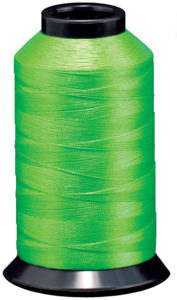
Synergy at work
American & Efird LLC (A&E) manufactures and distributes industrial and consumer sewing and embroidery thread and technical textiles. Among the users of the Mount Holly, N.C., company’s products are producers of apparel, automotive components, home furnishings, medical supplies and footwear. The company recently introduced a recycled core-spun industrial thread—Perma Core®—using Unifi’s REPREVE recycled fiber. The thread combines the REPREVE continuous filament polyester core with A&E’s polyester staple wrap, resulting in a high-quality, eco-friendly industrial sewing thread, says Jacob Blackburn, global marketing.
“Our customers requested a quality solution for producing complete products using REPREVE,” Blackburn says. “Partnering with Unifi makes for good synergy, as we both support each other’s environmental initiatives.”
The company’s long-standing environmental, health and safety, sustainability and social responsibility commitment has many components, expressed through its Eco•Driven® initiatives.
“These initiatives include our ‘10 Threads of Sustainability,’ among others,” says vice president Jimmy Summers. “Our commitment to provide sustainable products is one of these threads. It’s under this thread that Perma Core and A&E’s other sustainable and organic cotton products have been developed.”
Under another thread—Supply Chain Sustainability—the company is working with suppliers and customers to improve this aspect of its operations, says Summers.
“We engage with our suppliers to understand their approach to sustainability and to ensure our respective views are aligned,” he says. “We work together to optimize sustainability within our supply chain. We also work closely with our customers in a similar way.”
A&E also invests in sustainable technology, such as the wastewater treatment and recycling technology installed at many of its dyehouses worldwide, which has enabled the company to recycle and reuse over one billion liters of wastewater since 2013. Globally, A&E recycles and reuses nearly one million liters daily, says Summers. The company also uses the latest dye technology to minimize the amount of water required to dye thread products.
“This is water that doesn’t have to be removed from the environment, cleaned and returned to the environment,” says Summers. “In fact, A&E has two dyehouses that are zero liquid discharge operations, meaning no treated wastewater is discharged at all. In these operations, 92 percent of all water is recycled and reused.
“We believe sustainability is a never-ending process,” he adds. “We’re committed to continuing to meet challenges head-on in partnership with our suppliers and customers.”
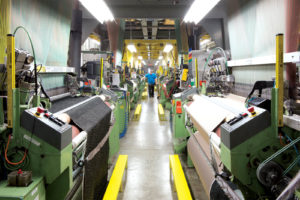
St-Georges, Quebec, Canada. Photo: Victor Textiles.
A collective understanding
The ANSI/NSF 336 standard (Sustainability Assessment for Commercial Furnishings Fabric) was released in 2013. The voluntary standard, used to evaluate and certify sustainability of commercial furnishings fabrics for their entire product life cycle, was years in the writing, says Hardy Sullivan, vice president of market development for Crypton Inc.
Headquartered in Bloomfield Hills, Mich., Crypton provides an array of performance fabrics in the contract and home furnishings markets. Some offerings include the company’s flagship Crypton® Super Fabric, the non-fluorinated C Zero, and Crypton® Green, 100 percent comprised of fabric scraps recycled into shoddy.
According to Sullivan, based at the company’s research and manufacturing facility in Kings Mountain, N.C., Crypton has a long history of producing patented and branded environmentally responsible textile solutions incorporating a variety of fiber types (polyester is the most common).
For example, the three textiles mentioned are free of triclosan, perfluorooctanoic acid (PFOA) and perfluorooctane sulfonate (PFOS)—as are all Crypton products. The fabrics utilize GREENGUARD Gold Certified technology, environmentally preferred chemistry, closed-loop industrial processes that recycle waste back into production and are recyclable, among other sustainability and performance characteristics. Many of the company’s fabrics—such as Crypton Super Fabric and Crypton Green—are third-party validated/proven compliant.
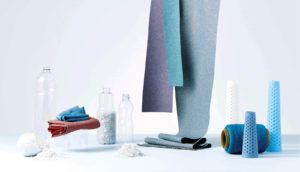
Always exacting in its quality and environmental requirements, the company became even more so in 2014 when it began complying with NSF 336.
“NSF 336 addresses material safety by restricting harmful materials when they present above industry thresholds—for example, 100 or 1,000 ppm—and giving optional points for excluding materials above the industry threshold that have concerns but don’t pose significant risks to workers or end users,” Sullivan explains. “For me, third-party validation/certification to an ANSI standard is the pinnacle of product stewardship.”
It’s a rigorous standard, making compliance difficult for many companies, especially non-vertical operations. Meeting the standard requires the entire supply chain to “get on board—both in mindset and action,” says Sullivan. (Crypton was involved in the standard’s development through a joint committee that included health officials, manufacturers, suppliers and other participants.)
Compliance meant making some changes. For example, one of the restricted materials is alkylphenol ethoxylates (APEs), commonly used surfactants in yarn lubrications. Crypton had to work with its suppliers to replace this substance with an acceptable alternative.
The need to standardize sustainability, creating a collective understanding, was the impetus behind the standard’s creation. “Companies all along the fabric supply chain want to ‘do good’ when it comes to sustainability, and in particular, material safety,” says Sullivan. “What used to be missing was the ‘how to.’ Now, we have the tool in NSF 336.
“My hope is that all companies along the supply chain gain a better understanding of NSF 336,” he continues. “We need a common set of guidelines capable of measuring progress. When downstream customers—those that specify and use commercial fabrics—learn about the process that went into developing the standard, I believe they’ll start asking for products certified to it.”
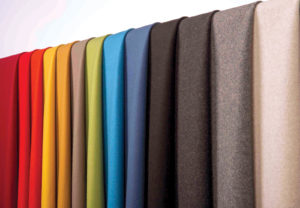
Rooted in sustainability
Based in Saint-Georges, Quebec, Canada, Victor Textiles serves the institutional, hospitality, educational, business offices and health care markets, providing contract textile design, development and manufacturing, says Amélie Lessard, corporate communications manager. Fabric applications include seating, panels, privacy curtains, acoustics and wall covering, using nylon, wool, polyester and other synthetic fibers.
“Victor produces proprietary and open line fabrics,” says Lessard. “We produce yarn from the fiber. We do package, yarn and piece dye, and we do the weaving and finishing.” (Victor also offers certified Crypton Super Fabrics, designing and weaving fabrics that are processed in Crypton’s Kings Mountain plant.)
Fifteen years ago the company created Victor Eco Intelligent Polyester®, a MBDC Cradle to Cradle Certified™ fabric. Similar to traditional polyesters in terms of performance and look, and used for all previously mentioned applications, it’s free of organohalogens and chlorine, and contains no chlorine dyes, auxiliaries or other inputs.
“Eco Intelligence® is our sustainable product line,” says Lessard. “It’s designed to remain in a closed-loop system of manufacture, reuse and recovery for sustained value through an unlimited number of product life cycles.”
Offerings in this line include Eco Intelligent Polyester, PC Recycled Polyester and several others.
Lessard says 95 percent of Victor’s products are completely recyclable after use, with recycled and optimized products comprising 75 percent of the company’s annual sales. Optimizing processes and production has enabled Victor to dramatically reduce its annual waste volume, resulting in less than one pound of waste going to landfills for each 100 pounds of fabric produced. The company—rooted in sustainability, says Lessard—carries several certifications, including ISO 14000 (a series of environmental managed standards).
“We also attained Facts sustainability certification a few years ago,” Lessard says. “To qualify, products must meet the rigorous requirements of the NFS/ANSI 336 standard.”
Five years ago, Victor “closed the loop” on its textile waste by partnering with Designtex (a Los Angeles designer/manufacturer of applied materials), Steelcase (a Grand Rapids, Mich., furniture manufacturer) and Unifi.
“These companies established a program whereby textile waste from Victor and Designtex products at Steelcase’s manufacturing facility is segregated, collected and sent to Unifi’s Repreve Recycling Center for recycling into REPREVE fiber,” she explains. “The yarn is then sent to Victor and developed into new woven products for Steelcase and Designtex.”
These sustainability strategies have helped the company build a business model for the future that protects the environment, Lessard says. “The various initiatives have also had positive impacts internally, as they have empowered the employees and reinforced the culture of innovation that is among Victor’s most important value.”
Pamela Mills-Senn is a freelance writer based in Long Beach, Calif.
Instead of focusing on just one attribute, the ANSI/NSF 336 standard—used to evaluate and certify sustainability of commercial furnishings fabrics—looks at fabrics over their entire life cycle, says Hardy Sullivan, vice president of market development for Crypton Inc. The company provides performance fabrics to the contract and home furnishings market, and was among the participants involved in the standard’s creation.
Utilizing a point system, NSF 336 evaluates furnishing fabrics in the areas of fiber sourcing, materials safety, water conservation, water quality, energy, air quality, recycling practices in manufacturing and end-of-use and social accountability. Total points determine if the fabric has achieved Conformant, Silver, Gold or Platinum level based on how fabrics measure up to the prerequisite requirements, performance criteria and quantifiable metrics in these areas.
Cradle to Cradle Certified™ (C2C) is an independent, third-party verification system, assessing products and materials for human safety, environmental health, design for future use cycles and sustainable manufacturing. Products are evaluated for material health, materials reutilization, renewable energy use, water stewardship and social fairness. There are five certification-award levels: Basic, Bronze, Silver, Gold and Platinum. MBDC, a Charlottesville, Va., firm, originated the C2C design framework and provides technical expertise to companies hoping to achieve the certification.
 TEXTILES.ORG
TEXTILES.ORG


